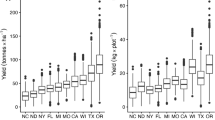Abstract
Easy-care or natural lambing pertainsto those sheep able to successfully lamb andrear at least one lamb without human assistancein a difficult environment. Such sheep may havea higher survival rate, lower lamb mortality,and require less shepherding at lambing thanother sheep breeds or strains. The farmer orshepherd account of easy-care lambing revealsseveral themes. Firstly, stock were bred tosurvive or suit local environments orconditions, particularly steep hill country inNew Zealand. This involved extensive culling ofundesirable dams, regardless of how well theymight perform in traits other than the abilityto survive and to produce live lambs atweaning. Sheep that did have problems wereoften assisted, recorded or marked and thenculled at an appropriate time; thus bothartificial (culling) and natural selection wereused. Secondly, natural selection enabled theimportant traits to be identified and they weresubsequently incorporated into artificialselection programs. Thirdly, the practice wasnecessitated by the impracticality ofsupervising lambing in difficult terrain andthe cost of skilled farm labor. Finally, it wasacknowledged that disturbance at lambingcreated problems and most importantly, theeasy-care approach reduced some of the problemstraditionally associated with lambing.Easy-care lambing systems thus aim to minimizesome of the detrimental effects associated withcarefully supervised lambing in someenvironments, by selecting sheep to suit boththat environment and modern farm management.They overcame pervasive influences our culturallegacy was exerting on the way we interact withanimals, and may have produced a system more inkeeping with the biology of the animal in anextensive environment.
Similar content being viewed by others
REFERENCES
Alexander, G., “Constraints to Lamb Survival,” in D. R. Lindsay and D. T. Pearce (eds.), Reproduction in Sheep (Australian Academy of Science and Australian Wool Corporation, Canberra, 1984), pp. 199–209.
Donnelley, S., “The Art of Moral Ecology,” Ecosystem Health 1 (1995), 170–176.
Fisher, M. (2000), “Animal Welfare - a Constraint or a Stimulus,” in D. Mellor, M. Fisher, and G. Sutherland (eds.), Innovation, Ethics, and Animal Welfare: Public Confidence in Science and Agriculture (ANZCCART, Wellington, 2000), pp. 68–72.
Fisher, M.W. and D. J. Mellor, “The Welfare Implications of Shepherding During Lambing in Extensive New Zealand Farming Systems,” Animal Welfare 11 (2002),157–170.
Kilgour, R. and H. de Langen, “Neonatal Behaviour in ‘Easy-Care’ Sheep,” in M. Wodzicka-Tomaszewka, T. N. Edey, and J. J. Lynch (eds.), Behaviour - Reviews in Rural Science, Behaviour in Relation to Reproduction, Management and Welfare of Farm Animals, Vol. 4 (University of New England Press, Armidale, 1980), pp. 117–118.
Knight, T. W., P. R. Lynch, D. R. H. Hall, and H-U P. Hockey, “Identification of Factors Contributing to the Improved Lamb Survival in Marshall Romney Sheep,” New Zealand Journal of Agricultural Research 31 (1988), 259–271.
Knight, T. W., L. D. Wilson, P. R. Lynch, and H-U P. Hockey, “Slope and the Choice of Birth Sites by Ewes,” New Zealand Journal Agricultural Research 32 (1989), 193–198.
Lyon, F., “How Farmers Research and Learn: The Case of Arable Farmers of East Anglia, UK,” Agriculture and Human Values 13 (1996), 39–47.
Mackereth, V. J., “A Practical View Point of Modern Sheep Breeding,” Proceedings Australian Society of Animal Production 15 (1984), 438–439.
McSporran, K. D. and E. D. Fielden, “Studies on Dystocia in Sheep. II: Pelvic Measurements of Ewes with Histories of Dystocia and Eutocia,” New Zealand Veterinary Journal 27 (1979), 75–78.
Midgley, M., Science as Salvation. A Modern Myth and its Meaning (Routledge, London, 1992).
Morris, M. C., “Ethical Issues Associated with Sheep Fly Strike Research, Prevention, and Control,” Journal of Agricultural and Environmental Ethics 13 (2000), 205–217.
Nowak, R., R. H. Porter, F. Levy, P. Orgeur, and B. Schaal, “Role of Mother-Young Interactions in the Survival of Offspring in Domestic Mammals,” Reviews of Reproduction 5 (2000), 153–163.
Ott, R. S., “Animal selection and Breeding Techniques that Create Diseased Populations and CompromiseWelfare,” Journal of the American Veterinary Medical Association 208 (1996), 1969–1974.
Phillips, C. J. C., “Animal Welfare Considerations in Future Breeding Programmes for Farm Livestock,” Animal Breeding Abstracts 65 (1997), 645–654.
Potter, V. R., “Bioethics, the Science of Survival,” Perspectives in Biology and Medicine (Autumn 1970), 127–153.
Rauw, W. M., E. R. Kanis, E. N. Noordhuizen-Stassen, and F. J. Grommers “Undesirable Side Effects of Selection for High Production Efficiency in Farm Animals: A Review,” Livestock Production Science 56 (1998), 15–33.
Rollin, B. E., Farm Animal Welfare. Social, Bioethical, and Research Issues (Iowa State University Press, Ames, 1995).
Rollin, B. E., “On Telos and Genetic Engineering,” in A. Holland and A. Johnson (eds.), Animal Biotechnology and Ethics (Chapman & Hall, London, 1998), pp. 156–171.
Roszak, T., The Engendered Atom. Reflections on the Sexual Psychology of Science (Barclay: Konari Press, Barclay, 1999).
Sandoe, P., N. Holtug, and H. B. Simonsen, “Ethical limits to Domestication,” Journal of Agricultural and Environmental Ethics 9 (1996), 114–122.
Scobie, D., “Back Off Man, I'm a Scientist,” in M. Fisher, J. Marbrook, and G. Sutherland (eds.), Learning, Animals and the Environment: Changing the Face of the Future, Wellington: ANZCCART, Wellington, 2002), pp. 82–89.
Scobie, D. R., A. R. Bray, and D. O'Connell, “A Breeding Goal to Improve the Welfare of Sheep,” Animal Welfare 8 (1999), 391–406.
Simm, G., J. Conington, S. C. Bishop, C. M. Dwyer, and S. Pattinson, “Genetic Selection for Extensive Conditions,” Applied Animal Behaviour Science 49 (1996), 47–59.
Walter, G., “A ‘Curious Blend’: The Successful farmer in American Farm Magazines, 1984- 1991,” Agriculture and Human Values 12(3) (1995), 55–68.
Warren, H. D., “Easy Care Shepherding,” Proceedings New Zealand Veterinary Association Sheep Society 5 (1975), 76–78.
Author information
Authors and Affiliations
Rights and permissions
About this article
Cite this article
Fisher, M. New Zealand Farmer Narratives of the Benefits of Reduced Human Intervention During Lambing in Extensive Farming Systems. Journal of Agricultural and Environmental Ethics 16, 77–90 (2003). https://doi.org/10.1023/A:1021758427469
Issue Date:
DOI: https://doi.org/10.1023/A:1021758427469




